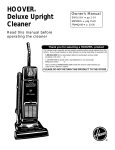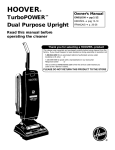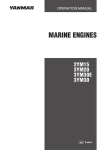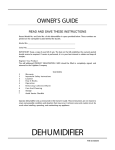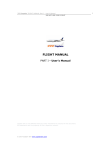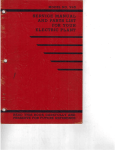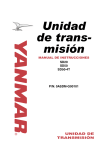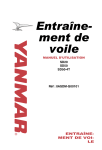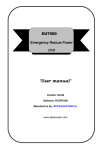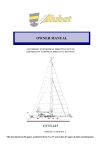Download G-Sail51 Owners Manual v1
Transcript
Hans Gunnervall – Meinrad Lienert Str. 23 – 8003 – Zuerich – Switzerland - +41 1 4629036 – [email protected] G-Sail construction G-Sail 51 Owner’s manual V 1.0 This document contains important information for the owner and skipper of the sailing catamaran G-Sail 51. Author(s) Hans Gunnervall Approval: Distribution: g-sail One copy should always stay on the boat. 12.01.09 1 Hans Gunnervall – Meinrad Lienert Str. 23 – 8003 – Zuerich – Switzerland - +41 1 4629036 – [email protected] Index Revision History .......................................................................................................2 1. Introduction.............................................................................................................3 1.1. Design category.........................................................................................................3 2. Technical Data ........................................................................................................4 2.1. Sail ............................................................................................................................4 3. Prevention of flooding and sinking...........................................................................6 3.1. 3.2. 3.3. 3.4. Hull construction.........................................................................................................6 Maximum recommended load......................................................................................6 O penings in the hull...................................................................................................6 Bilge pumps ..............................................................................................................8 4. Risk of fire ............................................................................................................10 4.1. 4.2. 4.3. 4.4. 4.5. 4.6. Engines ...................................................................................................................10 Electrical system ......................................................................................................10 Gas s ystem.............................................................................................................12 Storage of fuel .........................................................................................................13 Fire-fight equipment..................................................................................................13 Means of fire escape ...............................................................................................14 5. Boat Handling ......................................................................................................15 5.1. 5.2. Handling under power..............................................................................................15 Handling under sail...................................................................................................15 6. Safe operation .....................................................................................................16 6.1. 6.2. 6.3. 6.4. 6.5. 6.6. 6.7. 6.8. 6.9. Definition of working deck .........................................................................................16 Means of recover of man overboard.........................................................................17 Life raft stowage ......................................................................................................17 Escape hatches .......................................................................................................17 Emergency steering .................................................................................................18 O peration of navigation lights ..................................................................................18 Ventilation gas/engine ..............................................................................................21 Holding tanks ...........................................................................................................21 Lifting the vessel......................................................................................................22 Revision History Version & Date Change description 0.0 01.12.06 Initial draft 1.0 2.10.08 First complete version g-sail 12.01.09 2 Hans Gunnervall – Meinrad Lienert Str. 23 – 8003 – Zuerich – Switzerland - +41 1 4629036 – [email protected] 1. Introduction We share a common passion for the sea! This instruction guide is intended to help you to enjoy your boat in comfort and safety. It includes the boat specifications, the equipment provided or installed, the systems on board and tips on her use and maintenance. Read this manual carefully before you put out to sea so that you can make the most of her and avoid any damage and difficulties. Read the manual and familiarize yourself with the vessel before using it. For your comfort and safety if this is your first vessel or if your are changing to a new type of boat with which you are not familiar make sure that you obtain experience in preparing and handling before "taking command" of the vessel. Although everything possible has been planned and designed with the safety of the boat and its users in mind remember that sailing is highly dependent on the weather conditions and the sea state, and that only an experienced and very fit crew, handling a well-maintained boat, can sail satisfactorily. The sea and wind conditions that correspond to design categories A, B and C are changeable and are still susceptible to the risk of unusually large waves or strong gusts of wind. Total safety cannot therefore be guaranteed, even if your boat meets the requirements of a category. Always consult the weather and shipping forecasts before taking your boat out to sea. Make sure that you and your crew are able to handle the boat in these conditions. 1.1. Design category G-Sail 51 is designed for category A carrying max 12 persons and 2300 kg of baggage. Itʼs verified by extensive empirical testing. 1.1.1. Category A This boat is designed for sailing in winds exceeding force 8 on the Beaufort scale and in waves of a significant height of 4 m or more, and is to a large extent self-sufficient. Unusual conditions such as hurricanes are excluded. You may encounter such conditions when you sail long crossings, for instance transoceanic passages, or close to the shore when not protected from the wind or waves over a stretch of several hundred nautical miles. 1.1.2. Category B This boat is designed for sailing in winds not exceeding force 8 on the Beaufort scale and in waves of a corresponding height (significant height of 4 m or less). These conditions may be encountered out to sea or near the coastline when you are not protected from the wind and waves over several dozen nautical miles. These conditions may also be encountered in inshore waters of proportions sufficient to give waves as high as those mentioned above. 1.1.3. Category C This boat is designed for sailing in winds that may exceed force 6 on the Beaufort scale and in waves of a significant height of 2 m or less. Such conditions can be encountered in exposed inshore waters, in estuaries or in coastal waters in moderate weather. 1.1.4. Category D This boat is designed for sailing in winds not exceeding force 4 on the Beaufort scale and in waves of a corresponding size (occasional waves of 0.5 m maximum). Such conditions can be encountered in sheltered inshore waters and in coastal areas in good weather. g-sail 12.01.09 3 Hans Gunnervall – Meinrad Lienert Str. 23 – 8003 – Zuerich – Switzerland - +41 1 4629036 – [email protected] NB: The significant height of a wave is the average height of the upper third of the wave. This approximately corresponds to the height of the wave as assessed by an experienced observer. Some waves will be twice as high as this value. 2. Technical Data Type: Model: Serial: CIN: sailing catamaran G-Sail 51 G-SAIL001 SE-GSL00001G808 Hull material: plate: 4mm aluminium 5083 H321 and 4mm Alustar® stringers: 6061 T6 LOA: Beam: Draft: Light Displacement: 15.5 meters 7.9 meters 1 meter 10400 kg Certified by: Design category: Year of build: DNV (0575) A „Ocean“ 2008 Max nr. of people: 12 Max recommended load*: =2300 kg Engines (power): Engines (model): 2 x 29.08 kW (2 x 40 hp) Yanmar 3JH4E Fuel tanks: Water tanks: 2 * 330 L = Tot 660 L 8 * 180 L = Tot 1460 L Naval architect: Interior design/external styling: Peter Kerr (Lizard yachts Australia) Hans Gunnervall and Iria Hungerbuehler (G-Sail) *: Recommended load mean persons, luggage, food, loose equipment, and portable tanks. It does not include fixed tanks and what they contain. 2.1. Sail Main sail (5 bluestreak battens): 95 m2 Genoa: 66 m2 Gennacker: optional Storm sail: 10,5 m2 g-sail 12.01.09 4 Hans Gunnervall – Meinrad Lienert Str. 23 – 8003 – Zuerich – Switzerland - +41 1 4629036 – [email protected] 2.1.1. g-sail Rigg plan 12.01.09 5 Hans Gunnervall – Meinrad Lienert Str. 23 – 8003 – Zuerich – Switzerland - +41 1 4629036 – [email protected] 3. Prevention of flooding and sinking 3.1. Hull construction The hull, deck and superstructure of he G-sail 51 are all made out of aluminium. Each hull has 4 fully welded watertight bulkheads as shown in the following plan: The insulation is made out of 40 mm-closed cell foam and 15 mm closed rubber foam. The total volume of all closed materials and tanks in the construction is 13.63 m3 . The vessel fully loaded weighs 14967 kg. When the volume of all watertight compartments and equipment is taken into account, the total volume of buoyancy is 32.76 m3. See „Documentation of flotation“ for further information. 3.2. Maximum recommended load See „2. Technical data“. The load should, if possible, be put more to the aft then to the front and slightly more to the port side than to the starboard side, due to more installations (mainly two refrigerators) on the starboard side. 3.3. Openings in the hull 3.3.1. Openings above waterline 1. Kitchen sink ∅ 32 mm 2. Starboard toilet sink ∅ 20 mm 3. Port toilet sink ∅ 20 mm 4. Cabin one toilet sink ∅ 20 mm 5. Shower pump cabin one ∅ 20 mm g-sail 12.01.09 6 Hans Gunnervall – Meinrad Lienert Str. 23 – 8003 – Zuerich – Switzerland - +41 1 4629036 – [email protected] 6. Shower pump port toilet ∅ 20 mm 7. Bilge pump port skipper cabin ∅ 25 mm 8. Bilge pump starboard skipper cabin ∅ 25 mm 9. Bilge pump starboard ∅ 32 mm 10. Bilge pump port ∅ 32 mm 11. Bilge pump engineroom straboard ∅ 32 mm 12. Bilge pump engine room port ∅ 32 mm 13. Drainage aft hatch port ∅ 20 mm 14. Drainage aft hatch starboard ∅ 20 mm 15. Drainage engine hatch port ∅ 20 mm 16. Drainage engine hatch starboard ∅ 20 mm 3.3.2. Openings below waterline 17. Sail drive port 120*260mm 18. Sail drive starboard 129*260mm 19. Engine cooling water intake ∅ 20 mm (through sail drive) 20. Engine cooling water intake ∅ 20 mm (through sail drive) 21. Port toilet water intake ∅ 20 mm 22. Cabin one toilet water intake ∅ 20 mm 23. Starboard toilet water intake ∅ 20 mm 24. Starboard toilet outlet ∅ 25 mm 25. Port waist tank outlet ∅ 38 mm 26. Starboard waist tank outlet ∅ 38 mm 3.3.3. g-sail Plan of outlet positions 12.01.09 7 Hans Gunnervall – Meinrad Lienert Str. 23 – 8003 – Zuerich – Switzerland - +41 1 4629036 – [email protected] 3.4. Bilge pumps The G-sail 51 is equipped with 6 electrical and 4 manual fixed installed bilge pumps as follows. 3.4.1. Electrical Bilge pumps Bilge Brand Type Capacity 1. Port main Johnsson pump Submers. heavy duty 2200 GPH/8328 LPH 2. Stb. Main Johnsson pump Submers. heavy duty 2200 GPH/8328 LPH 3. Port engine room Johnsson pump Submers. heavy duty 2200 GPH/8328 LPH 4. Stb. Engine room Johnsson pump Submers. heavy duty 2200 GPH/8328 LPH 5. Port skipper cab. Johnsson pump Submers. heavy duty 1600 GPH/6057 LPH 6. Stb. skipper cab. Johnsson pump Submers. heavy duty 1600 GPH/6057 LPH The electrical bilge pumps have each one itʼs own control panel. The control panels are positioned within the electrical 12 V panel as shown in the following photos below. For detailed information se Mastervoltʼs user manual. All electrical bilge pumps are connected directly to the service batteries via a 50 Amp combined fuse and switch. The switch is positioned inside the electrical cupboard, under the nav table to the left. All electrical bilge pumps comply to: Recreational Craft Directive 94/25/EEC ISO 8849: 1990/Electrical operated bilge pumps ISO 8846: 1990/Electrical devices - Protection against ignition of surrounding flammable gases ISO 10133: 1994/Electrical systems - Extra low-voltage DC installations 3.4.2. Manual Bilge pumps Brand Type Capacity* Position 7. Port main Plastimo 1038 45 L/min Cockpit port side 8. Stb. Main Plastimo 1038 45 L/min Cockpit std. side Bilge g-sail 12.01.09 8 Hans Gunnervall – Meinrad Lienert Str. 23 – 8003 – Zuerich – Switzerland - +41 1 4629036 – [email protected] * 9. Port engine room Plastimo 1038 45 L/min Cockpit port side 10. Stb. engine room Plastimo 1038 45 L/min Cockpit std. side Capacity, as per ISO 15083 standard (45 strokes per minute, with a 10 kPA depression) The manual bilge pumps are equipped with a by-pass system patented by Plastimo in order to be able to use the same hose as the electrical bilge pump for a specific compartment. The Plastimo 1038 manual bilge pump comply to ISO 15083. For more information read Plastimos Ownerʼs Manual. 3.4.3. Safety precautions Check the function of all bilge pumps at regular intervals. Clear debris from the pump inlets. WARNING! The combined capacity of the system is not intended to drain the craft in the case of severe damage. g-sail 12.01.09 9 Hans Gunnervall – Meinrad Lienert Str. 23 – 8003 – Zuerich – Switzerland - +41 1 4629036 – [email protected] 3.4.4. Plan of bilge pump system 4. Risk of fire 4.1. Engines In order to prevent fire around the engines make sure the following: • • • • • • 4.2. Check regularly that the engine fan works. (It is wired directly to the ignition via a relay, so it will automatically run when the engine runs) Ensure flow of cooling water Ensure that ventilation openings are clear to prevent overheating Precautions when refuelling, e.g., no smoking and treatment of fuel spillage in boat Prevention of damage to fuel lines Avoidance of contact of flammable materials with hot engine parts. Electrical s ystem For detailed information on the electrical System, read “Documentation of installations” Mastervolt have produced the components in the electrical system. For detailed information on the components read the corresponding Owner’s Manual. The following information is needed in order o be able to prevent and to react in a case of emergency (fire, electric shock etc.) g-sail 12.01.09 10 Hans Gunnervall – Meinrad Lienert Str. 23 – 8003 – Zuerich – Switzerland - +41 1 4629036 – [email protected] 1. In order to turn the hole system off: a. Unplugg the shore cable (socket is positioned) b. Turn off the main switch for the service batteries (At the stb. side of the bench in the saloon) c. Turn off the main switches for the engine starter batteries. (In the cupboards under the beds in the aft cabins) 2. All fuses are automatic fuses (i.e. the switches in the electrical panel are also the fuses). There is no need for changing these fuses. When the failure is fixed, just switch on again. Some instruments have extra inline fuses close to the instrument (for ex. VHF, Autopilot clutch etc.) See respectively the Owner’s manual. 3. Make sure the ventilation openings for the battery boxes are free at all times. 4. When charging the battery, monitor the process carefully via Mastervolt’s remote panel for the Charger/Inverter positioned in the electrical panel. 5. Take precautions when connecting/disconnecting shore supply. Always disconnect on land first. 4.2.1. Positions of the main components 1. Service batteries 2. Main Switch 3. Switch for engine starter battery port 4. Switch for engine starter battery stb 5. Starter battery port 6. Starter battery stb 7. Socket for shore power g-sail 12.01.09 11 Hans Gunnervall – Meinrad Lienert Str. 23 – 8003 – Zuerich – Switzerland - +41 1 4629036 – [email protected] 4.3. Gas s ystem 4.3.1. Overview plans 1. 2. 3. 4. 5. 6. 7. 8. 9. g-sail 3kg international bottle “camping gaz” Reduction valve and on/off valve 8mm rubber hose with date marked, 0.65 meter Leakage tester Remotely maneuverable on/off valve. Needs power to open. The on/off button is situated in the kitchen over the sink. Copper pipe 8 *0,8 mm Double on/off valve 8mm rubber hose with date marked, 0,65 meter Gas stove by Siemens 12.01.09 12 Hans Gunnervall – Meinrad Lienert Str. 23 – 8003 – Zuerich – Switzerland - +41 1 4629036 – [email protected] 10. Gas oven by Technolor 4.3.2. Safe usage 1. Check the system regularly for leaks by pressing the read leakage tester situated in the stb. Cockpit locker next to the helm. While pressing observe the sight glass 2. Make sure the sight glass is o.k. and filled with glycol. 3. The two gas bottles on the vessel are only to be stored in the locker in the cockpit next to the helm. Specific bottle fittings are attached to the bottom of the locker. 4. When changing gas bottle: - turn of the remote valve by pressing off the switch in the kitchen - turn of the on/off valve at the bottle - Turn the bottle to left compared to the reduction valve 5. Only use the system for cocking. Make sure to avoid contact to hot areas. 4.4. Storage of fuel The vessel runs on diesel and the outboard engine for the dinghy runs on gas (with 1,5% 2 stroke oil mix) All containers that contain gas, diesel or oil must be stored in the engine compartments in the upper section! This since the engine rooms ha ve permanent ventilation under all conditions. 4.5. Fire-fight equipment The following types of fire fight equipment is on board the vessel G-sail 51: 1. Fire blanket: - Position: under the kitchen cupboard right next to the stove - Description: Use the blanket to fight a fire on the stove 2. 1kg ABC portable fire extinguisher - Position: in all double cabins in the locker under the seat. - Description: can be used on most types of fire, except metal fire. They also provide efficient results on mixed fires. 3. 2kg ABC portable fire extinguisher - Position: in all double cabins in the locker under the seat. - Description: can be used on most types of fire, except metal fire. They also provide efficient results on mixed fires. g-sail 12.01.09 13 Hans Gunnervall – Meinrad Lienert Str. 23 – 8003 – Zuerich – Switzerland - +41 1 4629036 – [email protected] 4. Sea-Fire automatic engine room fire extinguisher - Position: one in each engine compartment in the upper back of the bottom compartment - Description: The FG-100A contains the gas FM-200 and are dimensioned for a compartment up to 2.8 m3. The actual compartment size is 2.2 m3. This gas will instantly replace all oxygen and the fire will extinguish with no remains of the gas. The system is triggered when the engine room temperature is higher than 70 degrees Celsius. An alarm situated in the cockpit will sound as soon as the system is triggered. Read Sea Fire’s Owners Manual - Check the bottles regularly! 4.5.1. Plan of fire extinguishing equipment 4.6. Means of fire escape Escape ways are marked with the following sign g-sail 12.01.09 14 Hans Gunnervall – Meinrad Lienert Str. 23 – 8003 – Zuerich – Switzerland - +41 1 4629036 – [email protected] 4.6.1. Plan of escape ways 5. Boat Handling 5.1. Handling under power Make sure the skipper and the crew are well informed on how to handle the vessel under power. For information please read Yanmars Ownerʼs Manual. 5.2. Handling under sail The G-sail-51 has a massive sail plan and a powerful rigg. Make sure the skipper and crew are informed. The following warning symbols are positioned at the helm and must re considered: In the standard version the G-sail 51 has 3 sails, Main sail, Genoa and Storm Jib. After extensive testing G-sail Construction strongly recommends not to exceed the following Sail sets: 5.2.1. Sail set in winds not exceeding 4 Bf Full Main and full Genoa 5.2.2. Sail set in winds not exceeding 5 Bf 1st reef in Main and full Genoa g-sail 12.01.09 15 Hans Gunnervall – Meinrad Lienert Str. 23 – 8003 – Zuerich – Switzerland - +41 1 4629036 – [email protected] 5.2.3. 2 nd Sail set in winds not exceeding 6 Bf reef in main and 80 % of Genoa 5.2.4. Sail set in winds not exceeding 7 Bf rd 3 reef in Main and 60% of Genoa 5.2.5. Sail set in winds not exceeding 8 Bf rd 3 reef in Main and 40% of Genoa 5.2.6. Sail set in winds not exceeding 9 Bf No Main, 20% of Genoa or storm Jib 5.2.7. Sail set in winds not exceeding 10 Bf No main, no Genoa, storm Jib 5.2.8. Sail set in winds exceeding 10 Bf Bare pole Of course, the sail set depends on many things, like sea conditions, crew and angle, but these values are guidance for safe sailing. 6. Safe operation 6.1. Definition of working deck g-sail 12.01.09 16 Hans Gunnervall – Meinrad Lienert Str. 23 – 8003 – Zuerich – Switzerland - +41 1 4629036 – [email protected] 6.2. Means of recover of man overboard The recovery of man overboard is – relatively - very simple for a vessel of this. The G-Sail 51 offers 2 big swimming platforms only about 30 cm above sea level. A helping person can easily stand on the platform leaving enough room for the person who is to recover. Additionally a massive swimming ladder can be launched. The man overboard can launch the ladder from the water and so re-enter the boat. 6.3. Life raft stowage The life rafts must be stowed in the foreseen open compartments on the inner side of the hulls aft of the transom. These compartments are accessible also in an inverted state of the vessel 6.4. Escape hatches The Escape hatches are situated under the stairs - on port and starboard side - leading down from the saloon in to the hulls. The steps in the stairs are attached with industrial well crow, i.e. in case of emergency they can be toured away, in order to access the hatch The escape hatches are specially designed and made by Lewmar for this purpose. g-sail 12.01.09 17 Hans Gunnervall – Meinrad Lienert Str. 23 – 8003 – Zuerich – Switzerland - +41 1 4629036 – [email protected] 6.5. Emergenc y steering The wire steering is totally independent for both rudders. Therefore it is very unlikely, that both rudders will fail at the same time. If this is still the case an emergency steering can easily be rigged. Proceed as follows: 1. Unscrew the cap with a winch handle in order to access the rudderstock from above: 2. put in the emergency tiller 3. The emergency tiller can be extended with the boat hook, an aluminium pipe (situated in the port engine compartment) or any other stick. If a long stick is used, it will be possible for the helmsman to sit inside the cockpit. 6.6. Operation of na vigation lights The vessel G-sail 51 has two different sets of navigation lights. They are not intended to be used simultaneously, but to guarantee redundancy. Both systems correspond to COLREGS (International Regulations for Avoiding Collisions at Sea, Part C Rule 20 to 30) Additional to the navigation lights there is one 360 deg white anchor light at the mast top and one white steaming light at half mast height. All made by Aqua Signal. g-sail 12.01.09 18 Hans Gunnervall – Meinrad Lienert Str. 23 – 8003 – Zuerich – Switzerland - +41 1 4629036 – [email protected] 6.6.1. 1st system All lights are LEDs made by Aqua Signal (serie32) and are classified for vessels under 50 m of length according to COLREG Rule 22. 6.6.2. g-sail 2 nd system 12.01.09 19 Hans Gunnervall – Meinrad Lienert Str. 23 – 8003 – Zuerich – Switzerland - +41 1 4629036 – [email protected] A so called “Tricolor” is installed at the mast top. It is made by Aqua Signal (serie 40) and classified for vessels under 50 m of length according to COLREG Rule 22. The following certificate confirms the COLREG conformity g-sail 12.01.09 20 Hans Gunnervall – Meinrad Lienert Str. 23 – 8003 – Zuerich – Switzerland - +41 1 4629036 – [email protected] 6.7. Ventilation gas/engine There are two safety ventilations that are important to keep open. 6.7.1. The Saloon safety ventilation In order to prevent the accumulation of gas due to a leak in the gas system, the ventilation in the saloon should always be on. This includes the two dorado valves installed in the saloon roof hatches and the two ventilation openings in the sliding door. 6.7.2. The Engine room safety ventilation In order to prevent the accumulation of flammable fumes from gas and diesel containers and fixed installations the ventilation openings to the engine room should be kept free at all times. Check regularly. 6.8. Holding tanks See “Documentation of installations” for detailed information. The waist from the port toilets always goes into the port waist tank. The starboard toilet has a 2-way valve. The waist can go either directly over board, or into the holding tank. There are two ways to empty the holding tanks. 1. With a vacuum system, the tanks can be sucked out from the specified openings left and right from the mast foot. 2. There are seacocks right below the waist tanks. When opening the seacocks the waist will flow out. When marine laws prohibit the waist to go overboard, make sure: 1. that the valve in the starboard toilet cabinet is always in the position “to tank”. 2. That the seacocks are closed and have their handles secured by the corresponding wire. g-sail 12.01.09 21 Hans Gunnervall – Meinrad Lienert Str. 23 – 8003 – Zuerich – Switzerland - +41 1 4629036 – [email protected] 6.9. Lifting the vessel When taking the vessel in and out of the water use 4 long hoisting bets. The common lifting point should be as high as possible but not less than 10 m above deck. The position of the belts must be like in the following plans. g-sail 12.01.09 22 Hans Gunnervall – Meinrad Lienert Str. 23 – 8003 – Zuerich – Switzerland - +41 1 4629036 – [email protected] g-sail 12.01.09 23























